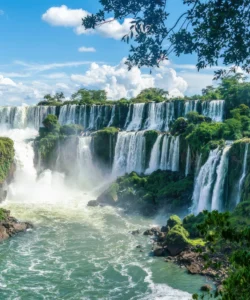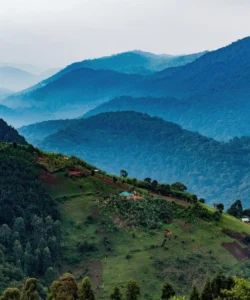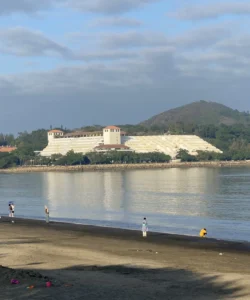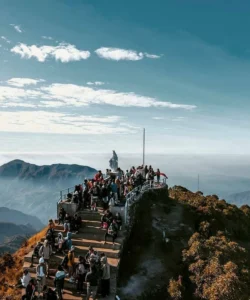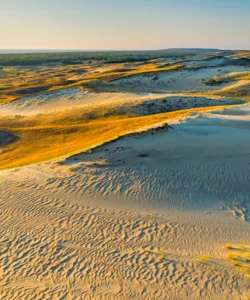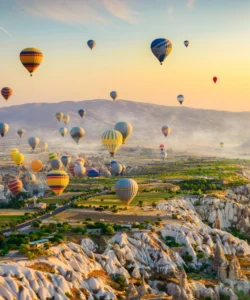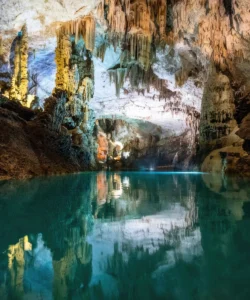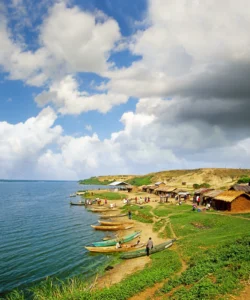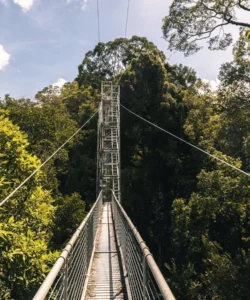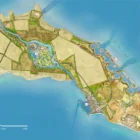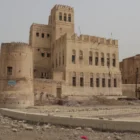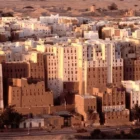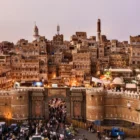The Arabian Desert is a monumental wilderness stretching across much of the Arabian Peninsula. It is a land of dramatic contrasts, from towering sand dunes to rugged mountains, and a region steeped in history, culture, and unique natural beauty.
Listen to an introduction about Arabian Desert
Name and Location
- Name: The Arabian Desert (Arabic: ٱلصَّحْرَاء ٱلْعَرَبِيَّة). It is also home to major sub-deserts, most famously the Rub’ al Khali (the Empty Quarter).
- Location: This vast desert wilderness occupies nearly the entire Arabian Peninsula, making it the largest desert in Asia and the fourth largest in the world. It spans across nine countries, with its largest portion lying within Saudi Arabia, and significant parts extending into Yemen, Oman, the United Arab Emirates, Qatar, Kuwait, Jordan, and Iraq. It is bordered by the Syrian Desert to the north, the Persian Gulf and Gulf of Oman to the northeast and east, the Arabian Sea and Gulf of Aden to the southeast and south, and the Red Sea to the west.
How to Get There
Given its immense size, there isn’t a single entry point to the Arabian Desert. Access for visitors is typically arranged through major cities within the countries it spans, particularly those known for desert tourism like Dubai, Abu Dhabi, or Salalah (Oman).
- Organized Tours: Most visitors experience the desert through organized desert safaris offered by tour operators from nearby urban centers. These tours often include activities like:
- Dune bashing in 4×4 vehicles.
- Camel riding, offering a traditional mode of desert travel.
- Sandboarding, similar to snowboarding on sand dunes.
- Quad biking or dune buggy rides.
- Stargazing under clear, dark skies, far from city lights.
- Overnight camping experiences with traditional dinners and cultural performances.
- Best Time to Visit: The cooler months from October to March are ideal for desert activities, as summer temperatures can be extreme.
Landscape and Features
The Arabian Desert is a mesmerising tapestry of diverse arid landscapes, defying the simple image of endless sand.
- Vast Sand Seas: The most iconic feature is its immense sand seas. The Rub’ al Khali (Empty Quarter), at its heart, is the world’s largest continuous body of sand, with dunes reaching heights of up to 250-300m (820-984ft). Other significant sand deserts include An Nafud in the north and the narrow Ad Dahna, which connects An Nafud to the Rub’ al Khali. The sands are predominantly silicates, colored orange, purple, and red by iron oxides.
- Rocky Plateaus and Gravel Plains: Beyond the dunes, the landscape includes extensive gravel plains (like Al-Ḥamād) and elevated plateaus. Prominent escarpments like the Tuwaiq Mountains in central Saudi Arabia feature dramatic limestone cliffs and canyons.
- Mountains and Wadis: Mountainous highlands rise in the western and southern parts (e.g., Sarawat Mountains, Oman Mountains), creating varied terrain. Numerous wadis (ephemeral riverbeds) dissect the landscape, occasionally holding water after rare rainfall, supporting sparse vegetation.
- Extreme Climate: The climate is predominantly hyper-arid, with annual rainfall often less than 100mm (3.9in). Temperatures vary wildly: summers can soar to 55∘C (131∘F) or higher, while winters can bring near-freezing temperatures, frost, and dew at night.
Flora and Fauna
Despite the harsh conditions, the Arabian Desert supports a surprising array of life, demonstrating remarkable adaptations.
- Flora: Plant life is sparse and often confined to wadis or depressions. Common species include drought-adapted Ghaf trees (Prosopis cineraria), various saltbush species (stabilizing dunes), and the striking yellow-flowered Desert Hyacinth. Date palms are abundant near oases.
- Fauna: Animals have evolved unique strategies for survival:
- Mammals: Iconic species include the majestic Arabian Oryx (reintroduced after near extinction), nimble Sand Gazelles (Reem), elusive Sand Cats (the only cat species exclusively found in deserts), Arabian Red Foxes, and Desert Hedgehogs. Dromedary camels are synonymous with the desert, known for their ability to withstand long periods without water and efficient water storage.
- Reptiles: Many species of snakes, lizards, and geckos thrive, such as the spiny-tailed lizard (Dhub), horned vipers, and monitor lizards.
- Birds: Ospreys, bustards, eagles, and various terns are among the bird species found here, with many migratory birds visiting coastal areas.
What Makes It Famous
The Arabian Desert’s fame stems from a combination of its vast natural beauty, ecological significance, and profound historical and cultural impact.
- Cradle of Arab Culture and Islam: It is considered the birthplace of Arab culture and the Islamic religion. Historic trade routes, most notably the Incense Route, traversed this desert for millennia, facilitating the exchange of frankincense, myrrh, spices, and other goods, which fueled the economic and cultural growth of the region.
- The Rub’ al Khali (Empty Quarter): Its status as the world’s largest continuous sand desert makes it a globally renowned natural wonder, a vast and forbidding yet awe-inspiring landscape.
- Petroleum Riches: Geologically, the Arabian Desert sits atop immense petroleum reserves, making the Arabian Peninsula the world’s richest petroleum-producing region. This has dramatically shaped modern global economics and politics.
- Extreme Environment and Resilience: The desert’s ability to host life in such extreme conditions showcases incredible natural resilience and adaptation, making it a subject of scientific fascination and conservation efforts.
- Historical Significance: Evidence of human habitation dates back to Pleistocene times, with ancient settlements, caravan routes, and rock art scattered throughout, telling tales of nomadic tribes and powerful empires.
Differences from Other Deserts
While sharing common characteristics with other deserts, the Arabian Desert possesses several distinguishing features.
- Scale and Contiguous Sand: While the Sahara Desert is larger overall, the Rub’ al Khali within the Arabian Desert is the largest continuous body of sand in the world. The Sahara also has a larger proportion of hyper-arid areas.
- Geological Origins and Resources: Unlike many deserts, the Arabian Desert’s geological history includes its separation from Africa, leading to vast petroleum formations beneath its surface, a feature not as prominent in deserts like the Gobi or Atacama.
- Climate Nuances: While all deserts are dry, the Arabian Desert experiences particularly extreme temperature fluctuations between day and night, alongside its scorching summer heat, and a unique influence from seasonal winds like the Shamals. The Gobi Desert, in contrast, is known for its extreme cold winters.
- Flora and Fauna Adaptation: The specific species adapted to the Arabian Desert, such as the Arabian Oryx and Sand Cat, are unique to this region, differing from the wildlife found in other major deserts.
- Cultural and Historical Depth: The Arabian Desert’s profound connection to the origins of Arab civilization, the Bedouin way of life, and the birth of Islam gives it a unique cultural and historical depth that sets it apart from many other deserts globally.
Arabian Desert Photos:































